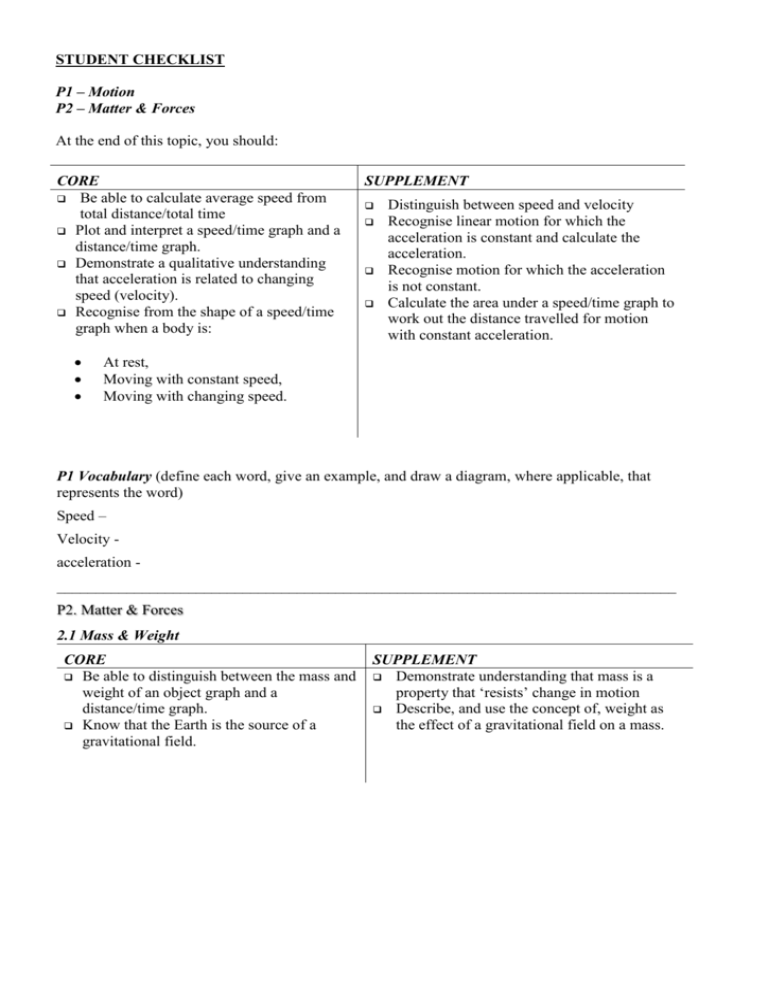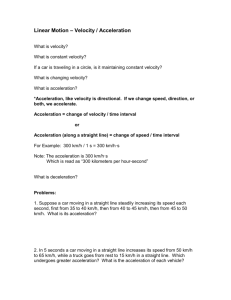P01 & P2 Student Checklist
advertisement

STUDENT CHECKLIST P1 – Motion P2 – Matter & Forces At the end of this topic, you should: CORE Be able to calculate average speed from total distance/total time Plot and interpret a speed/time graph and a distance/time graph. Demonstrate a qualitative understanding that acceleration is related to changing speed (velocity). Recognise from the shape of a speed/time graph when a body is: SUPPLEMENT Distinguish between speed and velocity Recognise linear motion for which the acceleration is constant and calculate the acceleration. Recognise motion for which the acceleration is not constant. Calculate the area under a speed/time graph to work out the distance travelled for motion with constant acceleration. At rest, Moving with constant speed, Moving with changing speed. P1 Vocabulary (define each word, give an example, and draw a diagram, where applicable, that represents the word) Speed – Velocity acceleration ________________________________________________________________________________ P2. Matter & Forces 2.1 Mass & Weight CORE Be able to distinguish between the mass and weight of an object graph and a distance/time graph. Know that the Earth is the source of a gravitational field. SUPPLEMENT Demonstrate understanding that mass is a property that ‘resists’ change in motion Describe, and use the concept of, weight as the effect of a gravitational field on a mass. 2.2 Density CORE Describe an experiment to determine the density of a liquid and of a regularly shaped solid and make the necessary calculation using the equation density = mass/volume or d = m/v. Describe the determination of the density of an irregularly shaped solid by the method of displacement, and make the necessary calculation. SUPPLEMENT 2.3 Effects of Forces CORE Know that a force is measured in newton’s (N). Describe how forces may change the size, shape, and motion of an object. Plot extension/load graphs and describe the associated experimental procedure. Find the resultant of two (2) or more forces acting along the same line. Explain how a system is in equilibrium when there is not resultant force. SUPPLEMENT Interpret extension/load graphs. State and use Hooke’s Law and recall and use the expression Force = constant x extension (F = kx) Recognise the significance of the term ‘limit of proportionality’ for an extension/load graph. Recall and use the relation between force, mass and acceleration (including the direction), F = ma P2 Vocabulary (define each word, give an example, and draw a diagram that represents the word where applicable) Mass – Weight – Density – Force – Pressure – Hooke’s law – P1 & 2 Equations Average Speed = Total distance/total time (avg. s = Total d/total t) Acceleration = change in velocity/change in time (a = Δv/ Δt) Density = mass/volume (D = m/v) Force = mass x acceleration (F = m x a) Pressure = force/acceleration (P = F/a) Hooke’s Law: load = spring constant x extension or force = constant x extension (F = kx) The spring constant will vary depending on the force and extension. K = F/x








